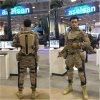Clockwork_Magic
*Gears turning*
Ordaria

The News
"Hello folks, thank you for tuning into OBC. Peace talks in Japan have come to an end resulting in the State of Japan becoming an independent nation. All Ordarian troops stationed and sent to Japan are now returning home. In other news, Prime Minister Krista Tera has called for the mobilization of the military in response to the Eastern Coalition's invasion of Germany and the Rising Empire. The fleet has been moved to the Baltic Sea in order to defend against a potential attack on Denmark. Humanitarian aid is also being sent to the victims of the war. The Ministry has also condemned the Riser's use of chemical weapons on civilian targets, stating the attacks were inhumane and unjustified."
 Kent
Kent
 Kazami42
Kazami42
 Am Vya
Am Vya

The News
"Hello folks, thank you for tuning into OBC. Peace talks in Japan have come to an end resulting in the State of Japan becoming an independent nation. All Ordarian troops stationed and sent to Japan are now returning home. In other news, Prime Minister Krista Tera has called for the mobilization of the military in response to the Eastern Coalition's invasion of Germany and the Rising Empire. The fleet has been moved to the Baltic Sea in order to defend against a potential attack on Denmark. Humanitarian aid is also being sent to the victims of the war. The Ministry has also condemned the Riser's use of chemical weapons on civilian targets, stating the attacks were inhumane and unjustified."


























































